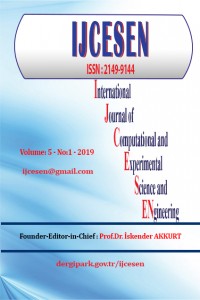Öz
Kaynakça
- F. Ersöz Türkiye ile OECD ülkelerinin sağlık düzeyleri ve sağlık harcamalarının analizi, İstatistikçiler Dergisi, 2 (2008) 95–104.
- F. Lorcu, B. A. Bolat, A. Atakisi, Examining Turkey and Member States of European Union in Terms of Health Perspectives of Millennium Development Goals, Quality & Quantity, 46 (2012) 959-978. DOI: 10.1007/s11135-011-9648-1
- N. Alptekin, Comparison of Turkey and European Union Countries’ Health Indicators by Using Fuzzy Clustering Analysis, International Journal of Business and Social Research, 4 (2014) 68-74. DOI: 10.18533/ijbsr.v4i10.607
- K. E. Lewandowski, S. H. Sperry, B. M. Cohen, D. Öngür, Cognitive variability in psychotic disorders: a cross-diagnostic cluster analysis, Psychological Medicine, 44 (2014) 3239-3248. DOI: 10.1017/S0033291714000774
- D. K. Moser, K. S. Lee, J. R. Wu, G. Mudd-Martin, T. Jaarsma, T. Y. Huang, X.Z. Fan, A. Strömberg, T. A. Lennie, B. Riegel, Identification of symptom clusters among patients with heart failure: An international observational study, International Journal of Nursing Studies 51 (2014) 1366-1372. DOI: 10.1016/j.ijnurstu.2014.02.004
- C. H. Olson, S. Dey, V. Kumar, K. A. Monsend, B. L. Westra, Clustering of elderly patient subgroups to identify medication-related readmission risks, International Journal of Medical Informatics 85 (2016) 43-52. DOI: 10.1016/j.ijmedinf.2015.10.004
- S. Tsumoto, S. Hirano, H. Iwata, Mining Schedule of Nursing Care based on Dual-Clustering, Procedia Computer Science, 55 (2015) 1203-1212. DOI: 10.1016/j.procs.2015.07.125
- J. MacQueen, Proc. Fifth Berkeley Symposium on Mathematical Statistics and Probability, 21 June – 18 July, 1965 and 27 December, 1965 - 7 January, 1966 Berkeley-USA.
- T. M. Kodinariya, P. R. Makwana, Review on determining number of Cluster in K-Means Clustering, International Journal of Advance Research in Computer Science and Management Studies, 6 (2013) 90-95.
- World Bank (26.03.2016). World Development Indicators. Link: http://data.worldbank.org/data-catalog/world-development-indicators Access data: 26.03.2016.
Öz
Health is always
considered as one of the most important issues related to human being. Due to
this importance, governments should primarily provide the best healthcare
services to their citizens. Some indicators can show the quality of healthcare
services in the country. However, one country can have a higher value of one
indicator and can have a lower value of another. Thus, countries can be
categorized in terms of quality of healthcare services. Clustering is a useful
tool for comparing countries and defining the similar countries in terms of
healthcare services. In this study, 28 European Union (EU) countries were
evaluated on 14 health factors and the number of clusters was determined by the
generally accepted rule of thumb. To cluster countries, k-means clustering
method is run in WEKA software for two cluster numbers and four different
initial solution approaches. The resulting clusters were evaluated according to
the Spearman rank correlation coefficient using the order of the GDP per capita
values of the countries in each cluster. It seems using four clusters with
Canopy initial solution approach is the most appropriate way of clustering.
Anahtar Kelimeler
Kaynakça
- F. Ersöz Türkiye ile OECD ülkelerinin sağlık düzeyleri ve sağlık harcamalarının analizi, İstatistikçiler Dergisi, 2 (2008) 95–104.
- F. Lorcu, B. A. Bolat, A. Atakisi, Examining Turkey and Member States of European Union in Terms of Health Perspectives of Millennium Development Goals, Quality & Quantity, 46 (2012) 959-978. DOI: 10.1007/s11135-011-9648-1
- N. Alptekin, Comparison of Turkey and European Union Countries’ Health Indicators by Using Fuzzy Clustering Analysis, International Journal of Business and Social Research, 4 (2014) 68-74. DOI: 10.18533/ijbsr.v4i10.607
- K. E. Lewandowski, S. H. Sperry, B. M. Cohen, D. Öngür, Cognitive variability in psychotic disorders: a cross-diagnostic cluster analysis, Psychological Medicine, 44 (2014) 3239-3248. DOI: 10.1017/S0033291714000774
- D. K. Moser, K. S. Lee, J. R. Wu, G. Mudd-Martin, T. Jaarsma, T. Y. Huang, X.Z. Fan, A. Strömberg, T. A. Lennie, B. Riegel, Identification of symptom clusters among patients with heart failure: An international observational study, International Journal of Nursing Studies 51 (2014) 1366-1372. DOI: 10.1016/j.ijnurstu.2014.02.004
- C. H. Olson, S. Dey, V. Kumar, K. A. Monsend, B. L. Westra, Clustering of elderly patient subgroups to identify medication-related readmission risks, International Journal of Medical Informatics 85 (2016) 43-52. DOI: 10.1016/j.ijmedinf.2015.10.004
- S. Tsumoto, S. Hirano, H. Iwata, Mining Schedule of Nursing Care based on Dual-Clustering, Procedia Computer Science, 55 (2015) 1203-1212. DOI: 10.1016/j.procs.2015.07.125
- J. MacQueen, Proc. Fifth Berkeley Symposium on Mathematical Statistics and Probability, 21 June – 18 July, 1965 and 27 December, 1965 - 7 January, 1966 Berkeley-USA.
- T. M. Kodinariya, P. R. Makwana, Review on determining number of Cluster in K-Means Clustering, International Journal of Advance Research in Computer Science and Management Studies, 6 (2013) 90-95.
- World Bank (26.03.2016). World Development Indicators. Link: http://data.worldbank.org/data-catalog/world-development-indicators Access data: 26.03.2016.
Ayrıntılar
| Birincil Dil | İngilizce |
|---|---|
| Konular | Mühendislik |
| Bölüm | Research Articles |
| Yazarlar | |
| Yayımlanma Tarihi | 31 Mart 2019 |
| Gönderilme Tarihi | 18 Nisan 2018 |
| Kabul Tarihi | 20 Ocak 2019 |
| Yayımlandığı Sayı | Yıl 2019 Cilt: 5 Sayı: 1 |

